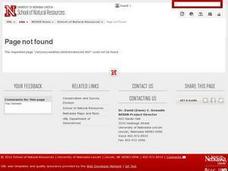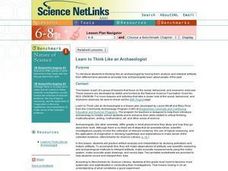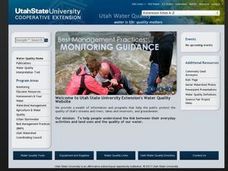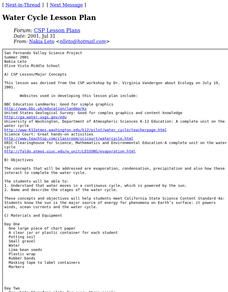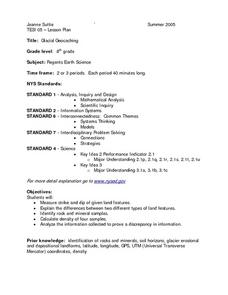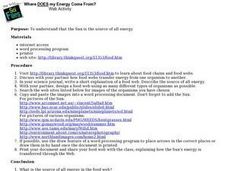Curated OER
The Water Dance
Students act like the changes in the four seasons by moving like water in each season.
Curated OER
Potato Fish Adaptations
Students examine fish adaptations. They identify types of adaptations, and create a 3-D model of an imaginary fish that demonstrates various adaptations using a potato and craft materials.
Curated OER
What's in the Water?
Young scholars examine water data for up to a month and perform tests on the samples.
Curated OER
Trees!
Students are introduced to the parts of trees through discussion and participation in learning centers with hands on activities that focus on each part.
Curated OER
Today's Weather on Mars
Students investigate the temperature and wind data locally, nationally, and internationally and compare these conditions to those on Mars. Conclusions are drawn about the differences of these conditions and the causes for the variance...
Curated OER
Am I Hot or Am I Cold?
Learners practice using a thermometer to determine how the air around the earth gets heated and cooled by the sun. Students chart the daily inside and outside temperature for two weeks.
Curated OER
Aqualung , the New Age Garden
Students examine how underwater landscape could be used for food production in the future. They discuss underwater landforms, draw a picture of an underwater landscape and a type of technology to use underwater, and write a description...
Curated OER
Development of Industrial New Hampshire
Pupils work in groups to research and share information about several different topics that were part of the development of Industrial New Hampshire. Students complete five parts of the project which include researching, role playing and...
Curated OER
The Great Migration
Sixth graders explore the uses of herbal plants. They read the book Pharmacy in the Forest and discuss the vocabulary words that pertain to the structure of a plant. Students create a summary of what they have read and watch a video on...
Curated OER
Shark Attack
Young scholars examine the white shark. They think critically about a set of shark facts and predict whether the statements are true or false. Students describe a year in the life of a white shark living in the Red Triangle. They...
Curated OER
Social Studies: Exploring Japan
Fourth graders examine the culture and environment of Japan, beginning with a KWL chart. They use clay and cups of water to construct representations of the Japanese Islands. After designing flags representing farming and food, 4th...
Curated OER
Getting To Know You:learning the Aza Ssp Terminology
Students discover the role zoos play in conservation of animals. They research the captive breeding programs that are in place at the Minnesota Zoo. They use the zoo's website to find the American Zoo and Aquarium Associations criteria...
Curated OER
Water Quality Monitoring
Students comprehend the four parameters of water quality. They perform tests for salinity, dissolved oxygen, pH and clarity or turbidity. Students comprehend why scientists and environmental managers monitor water uality and aquatic...
Curated OER
The Dead Zone: A Marine Horror Story
Learners graph dissolved oxygen versus depth using data taken from NECOP Program. In this marine science lesson, students explain the causes of hypoxia. They recommend possible solutions to this problem.
Curated OER
Leaarn to Think Like an Archaeologist
Students examine how to act as archaeologists by examining artifacts. The inquiry is meant to teach learners about analysis of ancient civilizations and scientific finds. Fossil evidence is also covered to make connection to the...
Curated OER
Riparian Review
Students engage in the process of researching a riparian ecosystem. They conduct a field trip in order to obtain different types of data and work on measurement skills to analyze data to form a conclusion about the biotic factors of the...
Curated OER
Water Cycle
Middle schoolers identify and define evaporation, condensation, precipitation and also, how these interact to complete the water cycle. They identify that water moves in a contimuous cycle, which is powered by the sun. Finally,...
Curated OER
Measuring the Diameter of Our Star
Learners conduct an experiment to measure the diameter of the sun. For this astronomy lesson, students construct a simple equipment to collect scientific data. They calculate the sun's diameter using a given formula.
Curated OER
Tracking Sunrise and Sunset
Students collect, record, and graph the sunrise and sunset times. They explain how the relationship between the tilt of Earth's axis and its yearly orbit around the sun produces the seasons.
Curated OER
What Repair Proteins are Expressed in C-Ferns After Exposure to Varying Amounts of UV Radiation?
Students examine the life cycle of c-ferns. They complete experiments on the organisms exposing them to differnet amount of UV radiation. They collect data and analyze their results.
Curated OER
Glacial Geocaching
Eighth graders measure strike and dip of given land features and explain the difference between them. They also look at rock and mineral samples for indentification, along with calculating the density. Finally, information is analyzed...
Curated OER
Geologic Hazards WebQuest
Students brainstorm a list of geological hazards that have occured in the past. In groups, they research one of the hazards to identify its cause, repsonses and impact. They must also interview a scientist on the issue to analyze their...
Curated OER
Simple Harmonic Motion
Students study harmonic motion and its oscillation. In this simple harmonic motion lesson students demonstrate a series of regular oscillations and explain the theory behind the experiment.
Curated OER
Where Does My Energy Come From?
Students gain an understanding that the Sun is the source of all energy. With a partner, they examine various web sites to explore food chains and food webs, later sharing their findings with the class.







